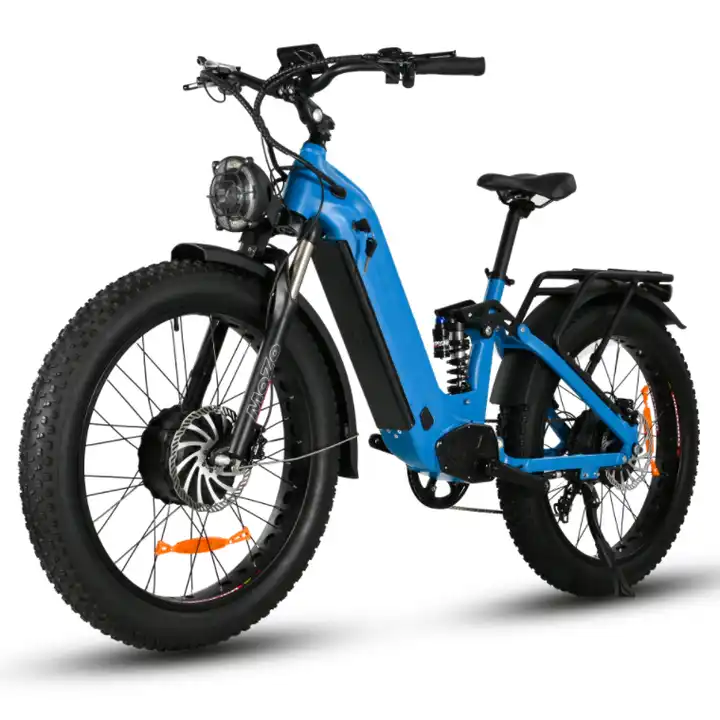A mountain eBike (electric mountain bike) is designed for off-road cycling

A mountain eBike (electric mountain bike) is designed for off-road cycling, combining traditional mountain bike features with electric assistance to make climbing hills and tackling rough terrain easier.

Here are key aspects to consider:
1. Key Features of Mountain eBikes
- Motor: Typically mid-drive (better weight distribution, efficiency) or hub-drive (simpler, cheaper).
- Power: Ranges from 250W (legal limit in Europe) to 750W (common in the U.S.).
- Battery: 400Wh to 750Wh capacity; affects range (20–80 miles per charge).
- Suspension:
- Hardtail: Front suspension only (lighter, efficient for smooth trails).
- Full-suspension: Front + rear suspension (better for rough terrain).
- Tires: Wide, knobby tires (2.4″–2.8″) for traction.
- Frame: Durable aluminum or carbon fiber.
- Assist Modes: Eco, Trail, Turbo (adjustable via handlebar controls).
2. Benefits of Mountain eBikes
- Easier Climbing: Electric assist helps conquer steep hills.
- Longer Rides: Extends range compared to traditional MTBs.
- Accessibility: Allows riders of different fitness levels to enjoy trails.
- Fun Factor: More speed and less fatigue on technical terrain.
3. Popular Mountain eBike Categories
- Trail eBikes: Balanced for climbing and descending (e.g., Specialized Turbo Levo).
- Enduro eBikes: Built for aggressive downhill + uphill (e.g., Trek Rail).
- Downhill eBikes: Focused on downhill performance (rare, often heavy).
- Hardtail eBikes: Budget-friendly, efficient for light trails (e.g., Cannondale Trail Neo).
4. Considerations Before Buying
- Budget: 2,000–10,000+ (high-end models have better components).
- Weight: 40–60 lbs (heavier than regular MTBs).
- Local Laws: Check motor power/speed limits (e.g., 250W/15.5 mph in EU, 750W/28 mph in U.S.).
- Maintenance: More complex than analog bikes (battery care, motor servicing).
- 20 inch alloy off-road commuting mountain bike for adult ebikes
- 36V 10.2Ah Electric power-assisted integrated mountain bike
- Folding electric bicycle lithium battery ultra-light portable ebikes
- How to buy ebikes or escooters?
- What is electric bike?
- What’s an electric scooter?
- G30 electric scooters 10”,36V15AH,40-45KM
- Off-road1200W brushless motor escooters MAX speed 70KM/H
- Ebike and escooters are our main products
- Chinebike has a global presence with its products being sold in numerous countries
- CHINE ESCOOTERS FACTORY
- CHINE EBIKE MANUFACTURER
- scooters for kids
- EBIKES SITUATION IN THE WORLD 2025
- The Best Rear Cargo Ebike 2024-2025
- CHINEBIKE has over 17 years of experience in researching, designing, and manufacturing electric bikes
- Electric bicycles, known as e-bikes, have gained significant popularity in recent years
- We focus on electric mountain bikes,EMTB.
- One of Chinebike key areas of focus is electric mountain bikes.
- We are a professional manufacturer of electric bicycles and electric scooters.
- What’s difference of eMTB and MTB ?
- What’s difference of ebikes and EMTB?
- How to use hunting ebike?
- USDA Forest Service Issues Guidance to Manage Future E-Bike Use on National Forests and Grasslands
- Where Is a Hunting Electric Bike Legal?
- Revolutionize Urban Commuting with the Electric Scooter
- eCargo can rely on the powerful and efficient
- DRIVE SYSTEMS FOR eMTB
- E-MTBs becomes ever more popular
- Is an e-MTB right for me?
- How far will my e-MTB go? What’s the battery range?
- How does an e-MTB work?
- e-MTB Full Suspension
- Ridding your EMTB in Bike Park
- Full Suspension Fat Tire Electric Bicycle mid-drive motor
- Fat Tire Electric Bike with two batteries
- Folding Ebikes New Arrival
- What is Mobility Scooter?
- What is folding Ebikes?
- What is EMTB?
- What is Electric Scooter?
- What is Electric Bike?
- City Bike
- Electric Tricycle
- 2023 Electric Scooters
- Electric Mountain Bike
- Electric Bikes
- Electric Scooter
- Welcome to ChineBike.com
Leave a Reply